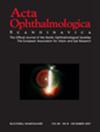Topographic determinants of anterior chamber angle narrowing in patients with keratoconus
Abstract
Purpose: To identify topographic determinants of the anterior chamber angle in a sample of patients with keratoconus.
Methods: Two hundred patients who visited a tertiary eye hospital and were diagnosed with keratoconus, were recruited for this study. First, complete ocular examinations were performed for all patients, including measurement of uncorrected distance visual acuity, objective and subjective refraction, and slit-lamp biomicroscopy. Then, all study participants underwent corneal imaging by the Pentacam rotating Scheimpflug imaging system. The keratoconus was diagnosed based on distorted keratometric mires, scissoring of retinoscopic reflex, abnormal corneal topography (inferior-superior asymmetry, focal or inferior steepening, or a bow-tie pattern with skewed radial axes > 21°) consistent with keratoconus as well as the presence of at least one keratoconus biomicroscopic sign.
Results: The mean age of study participants was 32.40± 8.52 years (15-60 years) and 69.5% of them were male. No statistically significant difference was found in the anterior chamber angle between males and females (p-value = 0.447). There was a statistically significant inverse correlation between anterior chamber angle and age (r = -0.262, p-value < 0.001). The mean anterior chamber angle was significantly different among different groups of cone morphology; patients with nipple cone had the lowest mean anterior chamber angle (p-value = 0.001). Moreover, there was a statistically significant difference in the mean anterior chamber angle among different groups of cone location; the lowest mean anterior chamber angle belonged to patients with central cones (p < 0.001). Anterior and posterior Q-values were significantly directly correlated with anterior chamber angle (anterior Q: r = 0.122, p-value = 0.014, posterior Q: r = 0.192, p-value < 0.001).
Conclusions: Keratoconus patients with nipple and central cones and more negative Q-values were more prone to anterior chamber angle narrowing. It is recommended that the risk of angle closure be taken into account in this group of patients for diagnostic and treatment procedures.

 求助内容:
求助内容: 应助结果提醒方式:
应助结果提醒方式:


